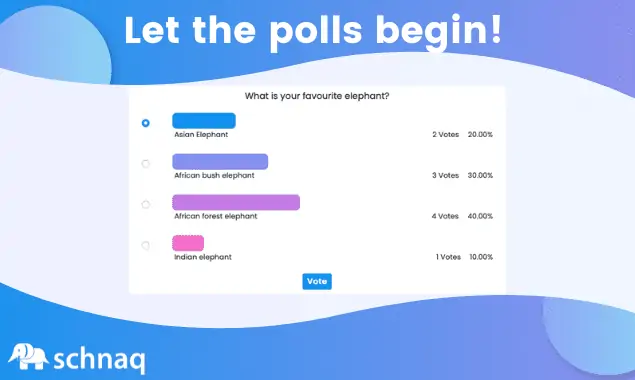The Ultimate Guide to Online Polls: Benefits and Best Practices
By Alexander Schneider
Are you thinking about using polls for your events, workshops, or social media? Are you not sure how to use them properly and get lots of engagement?
Fear not! This guide will show you the benefits of online polls and demonstrate use cases. It also discusses eight best practices and tips that make your polls as engaging as possible.
What are polls good for anyway?
Polls have many positive effects on your audience, even if it’s not apparent at first. Let’s talk about the three main ones.
Gather Feedback
Polls are an excellent tool to gather feedback from your audience. There’s no need to go around and ask everybody one by one. Just create a poll and let the voting begin!
Find out what your audience thinks about
Gain insights on what your audience is thinking on specific topics. Use polls as tools that help you tailor your talk to the audience’s interests.
Engage the Audience
Talking to an audience should not be a one-way conversation. It’s the same for social media and live presentations. People love engagement, and polls are an easy way of involving everybody in your audience without too much effort.
Use-cases for polls
You now understand the advantages of using polls. Next, take a look at some example use-cases.
Get to know your audience
 To properly engage your audience, you need to know who they are. Why not just ask? © Unsplash
To properly engage your audience, you need to know who they are. Why not just ask? © Unsplash
This one is straightforward. Create several polls where you ask your audience, for example:
- “What country are you from?”
- “What is your occupation?”
- “How did you hear about this event?”
But be respectful with the questions and try not to make the questions too personal.
Mood Check
Mood checks are nice to have in the middle of an event. You can ask your audience how they feel right now. Provide a few options that can be humorous as well. For example: “Sunny, Cloudy, Rainy, Like a hot summer afternoon.”
With this poll, you can quickly know how your audience feels and react accordingly. Are most people getting tired? Time for a pause or some activity!
Icebreakers
Icebreakers are a perfect way to start events and meetings. They help people “arrive” mentally and get ready for the event. You can ask questions like:
- “Which song would you ban from all Karaoke nights?”
- “If you could be one of the following animals, which would it be?”
- “What is your favorite season?”
Get creative and try to use some humor in the pre-defined choices.
Measure Satisfaction
As the last action of an event or meeting, you can use polls to let the audience or participants leave a rating. It does not have to be a scale from one to five stars. You could also do the following:
“What did you think about the meeting?”
- Everything was fine
- It was too long
- I would have liked more pauses
- The presentation was lacking
- etc.
This way, you will know when you need to change something. The same goes for events.
Best Practices for Engaging Polls
Polls seem easy on the outside. But some engage the audience more than others. Here are eight tips to get the most out of your online polling.
 Do you know whether this poll would perform well? Check the eight tips below to be a poll pro in no time!
Do you know whether this poll would perform well? Check the eight tips below to be a poll pro in no time!
1. Discuss the results
Never make the mistake of not at least briefly talking about the results of your poll. If you poll your audience and never talk about the results, the participation rates will drop. Nobody likes being ignored.
2. Choose the correct type of poll
Take care to utilize the correct type of poll. For example, allow choosing multiple options when asking for types of birds they know. After all, there is more than one! In the same vein, only allow one answer when you ask about the favorite in some category.
3. ****Allocate time for the voting itself
If we’re talking live events or meetings, do not open up a poll and continue talking. One of two things will happen: people stop paying attention to you so they can vote. Or they keep listening but will not participate in the poll.
Give your audience 10 – 30 seconds to cast their vote before you move on.
4. Keep Questions neutral
A poll will give you no insights if the question contains an opinion. “What would you criticize about Franks presentation?” and “What would you note about Franks presentation?” may mean the same thing but have vastly differing undertones. Try to make the question as neutral as possible and let the audience make up their mind themselves.
5. Use balanced options
 If you are polling with answers that could be a scale, try to balance out all options. There should be a “very much applicable” for every “not applicable at all”. © Unsplash
If you are polling with answers that could be a scale, try to balance out all options. There should be a “very much applicable” for every “not applicable at all”. © Unsplash
If you poll using questions that let the audience rate things, you should keep the answer options balanced. For example, if the choices are “not good”, “mostly not good” and “neutral”, there should also be two options balancing out the negative ones. Namely: “mostly good” and “good”.
6. Don’t ask similar questions
If you have multiple polls, make sure that all questions are different from each other. It is easy to have some overlap but will lead to an audience not being willing to answer too many things at once.
7. Make the question clear
Make every question crystal clear without any room for interpretation. Polls with precise questions have the best participation rates and the best data outcome. Room for interpretation will muddle your results.
8. Use questions that benefit the audience
You could ask about almost anything, and if you follow all the tips above will have a decent outcome. But if the questions and results do not benefit your audience, they will contribute to less participation in the future.
So how do the questions benefit your audience? By being designed with their desires and interests in mind. Don’t ask nature-enthusiasts about the benefits of all-inclusive travel.
Do you want to try out your newly learned polling skills? Schnaq allows you to create as many polls as you like for your audience. Give it a try and engage your audience like a Pro!